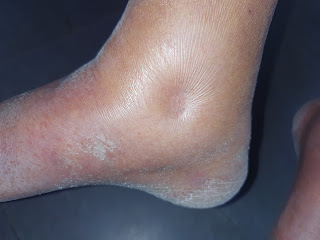72 YEAR OLD MALE WITH BILATERAL PEDAL EDEMA
Kausalya Varma, Intern
This is online E log book to discuss our patient’s de-identified health data shared after taking his/her/guardian’s signed informed consent. Here we discuss our individual patient’s problems through series of inputs from available global online community of experts with an aim to solve those patients clinical problems with collective current best evidence based inputs. This e-log book also reflects my patient centered online learning portfolio and your valuable inputs on comment box is welcome.
I’ve been given this case to solve in an attempt to understand the topic of “patient clinical data analysis" to develop my competency in reading and comprehending clinical data including history, clinical findings, investigations, and come up with diagnosis and treatment plan.
AN 72 YEAR OLD MALE BROUGHT TO THE HOSPITAL WITH BILATERAL PEDAL EDEMA AND DECREASED URINE OUTPUT
CASE:
CHIEF COMPLAINTS:
Temperature: Afebrile
RESPIRATORY SYSTEM-
Inspection-
Chest is bilaterally symmetrical
The trachea is positioned centrally
Apical impulse is not appreciated
Chest moves normally with respiration
No dilated veins, scars or sinuses are seen
Palpation-
Trachea is felt in the midline
Chest moves equally on both sides
Apical impulse is felt in the fifth intercostal space
Tactile vocal fremitus- appreciated
Percussion-
The areas percussed include the supraclavicular, infraclavicular, mammary, axillary, infraaxillary, suprascapular, infrascapular areas.
They are all resonant.
Auscultation-
Normal vesicular breath sounds are heard
No adventitious sounds heard
CARDIOVASCULAR SYSTEM-
Inspection-
The chest wall is bilaterally symmetrical
No dilated veins, scars or sinuses are seen
Apical impulse or pulsations cannot be appreciated
Palpation-
Apical impulse is felt in the fifth intercostal space, 2 cm away from the midclavicular line
No parasternal heave or thrills are felt
Percussion-
Right and left borders of the heart are percussed
Auscultation-
S1 and S2 heard, no added thrills and murmurs are heard
CENTRAL NERVOUS SYSTEM-
CENTRAL NERVOUS SYSTEM EXAMINATION-
Higher mental functions
- Conscious
- Oriented to time,place and person
- Memory - Intact
- Speech - no deficit
Cranial nerve examination
• 1 - olfactory sense - normal
• 2- Direct and indirect light reflex present
• 3,4,6 - no ptosis Or nystagmus
• 5- corneal reflex present
• 7- no deviation of mouth, no loss of nasolabial folds, forehead wrinkling present
• 8- Decreased hearing
• 9,10- position of uvula is central ,Gag reflex- present
• 11- sternocleidomastoid contraction present
• 12- no deviation of tongue
Motor system
Attitude - left and right lower limb flexed at knee joint
Reflexes
Right Left
Biceps 3+ 3+
Triceps 3+ 3+
Supinator 2+ 2+
Knee. 3+. 2+
Ankle. 2+. 2+
Power. Lt. Rt
Upper limb -5/5. 5/5
Lower limb -5/5 5/5
TONE. Lt. Rt
Upper limbs N N
Lower limbs N N
No Involuntary movementss
SENSORY SYSTEM
I – SPINOTHALAMIC R L
1. Crude touch N N
2. Pain. N. N
3. Temperature. N. N
II – POSTERIOR COLUMN
1. Fine touch. N. N
2. Vibration. N. N
3. Position sense. N. N
4. Romberg’s sign -Negitive
III – CORTICAL
1. Two point
discrimination. N. N
2. Tactile localisation. N. N
3. Graphaesthesia. N. N
4. Stereognosis. N. N
CEREBELLAR Tests
No Nystagmus
Finger Nose test - normal
Heel Knee test - normal
Dysdiadokokinesia - normal






Comments
Post a Comment